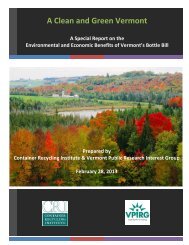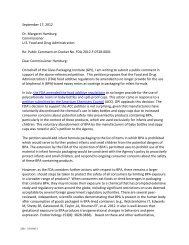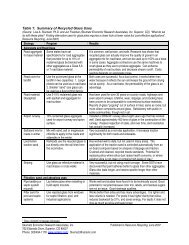First step, partner up BY CONNI KUNZLER - Glass Packaging Institute
First step, partner up BY CONNI KUNZLER - Glass Packaging Institute
First step, partner up BY CONNI KUNZLER - Glass Packaging Institute
You also want an ePaper? Increase the reach of your titles
YUMPU automatically turns print PDFs into web optimized ePapers that Google loves.
Sidebar 1: Best practices<br />
Build <strong>partner</strong>ships that utilize and<br />
advance the local economy. The<br />
food service businesses, hauler<br />
or recycler, and glass processor<br />
working in tandem ensure that the<br />
recycled glass is returned to a glass<br />
container manufacturer for closedloop<br />
recycling. Cities and counties<br />
can be adept at helping to create<br />
these connections and bring all the<br />
parties together.<br />
Ensure sufficient participants<br />
for economic feasibility. There<br />
need to be sufficient participants<br />
to a fill a collection vehicle on a<br />
daily route to establish economic<br />
feasibility. This is a useful guide<br />
for determining the number of<br />
businesses that would be required<br />
to establish a viable program.<br />
Don’t underestimate “set <strong>up</strong>”<br />
time and personnel requirements.<br />
There is an initial requirement<br />
of personnel time to work with<br />
each business and set <strong>up</strong> the<br />
program, including assistance<br />
And in Cincinnati, Hamilton County<br />
<strong>partner</strong>ed with local waste/recycling companies,<br />
allowing businesses to reduce trash<br />
collection while adding recycling services.<br />
Getting started<br />
The majority of programs began within the<br />
past six years, and several within the past<br />
two years. Of the ten programs surveyed, on<br />
average, they have been in operation just over<br />
four years. The longest is 19 years old and the<br />
shortest has been in operation eight months.<br />
Taking out the program in existence for 19<br />
years, the outlier, the average length of time in<br />
operation is 2.75 years.<br />
Most programs were initiated to handle<br />
the volume of glass generated at bars, restaurants<br />
and hotels, as well as the environmental<br />
impact of recycling glass versus including<br />
it with the trash. According to Holly<br />
Christmann, Solid Waste Program Manager,<br />
Hamilton, Ohio, “We were getting more<br />
calls from bars and restaurants for assistance<br />
with glass recycling and realized we hadn’t<br />
addressed this sector and could get a lot<br />
of glass – and cardboard – if we provided<br />
assistance.”<br />
20 RR | October 2011<br />
with containers, logistics, training,<br />
signage, contracts, etc.<br />
Consider separate glass collection<br />
for a closed-loop end market.<br />
Separated glass collection is optimal<br />
to ensure recycled glass is used to<br />
make new glass container. While<br />
some single streams MRFs can<br />
produce sufficient quality recycled<br />
glass to be taken to a cullet<br />
processor and eventually a closedloop<br />
glass market, this results in<br />
glass loss. Single stream collection<br />
also requires processing both at a<br />
MRF and a cullet processor, which<br />
adds costs.<br />
At a minimum ensure cost neutral<br />
economics. Economics must<br />
allow for the collection of glass<br />
containers to be cost neutral,<br />
or lower, to the participating<br />
businesses. The hauler also will<br />
expect to net some profit or at<br />
minimum not incur additional costs.<br />
Work with a collection team<br />
In some cases it was motivated by generating<br />
a higher quality and volume of recycled<br />
glass for a targeted end market. “Be<br />
creative and customize your own program,”<br />
says Brad Tomm, sustainability manager<br />
for MGM Resorts International. At the 10<br />
MGM hotels in Las Vegas, they have the<br />
space and resources to sort recyclables on<br />
site, and then they sought out a recycled<br />
glass processor with an end market that<br />
returns the glass to new bottles.<br />
Rounding <strong>up</strong><br />
participants is a<br />
hands-on job<br />
Surveyed programs indicated that there was<br />
an initial requirement of personnel time<br />
to work with each business and set <strong>up</strong> the<br />
program. This primarily involved assistance<br />
with recycling containers, logistics, training,<br />
signage, contracts, etc. This is another vital<br />
element of a successful program.<br />
On average, 100 bars, restaurants<br />
and hotels participate in each surveyed<br />
programs. The smallest program has 10<br />
participating businesses and the largest<br />
committed to glass quality. The<br />
hauler/recycling collector is a<br />
key <strong>partner</strong>. Work with a hauler<br />
or recycler that is committed to<br />
glass quality and is working with<br />
a closed-loop end market for the<br />
recycled glass containers. The<br />
hauler or recycler is also critical<br />
to working through logistics and<br />
economics.<br />
Match storage containers,<br />
collection vehicles, and participants.<br />
Pay attention to outside storage<br />
space and collection vehicle<br />
accessibility. Inside, it’s more<br />
musical bins.<br />
Keep inside collection containers<br />
adaptable and clearly marked.<br />
Nearly all bars and restaurants<br />
use Slim Jims (no wheels and<br />
23 gallon) or similar, like Brute<br />
(wheeled and 50 gallon) for inside/<br />
behind bar collection. Consider<br />
signage (English and Spanish) and<br />
color of containers to help with<br />
contamination.<br />
has 330. One program includes 10 large<br />
hotels. Of those reporting, on average, each<br />
business is generating about one ton per<br />
month of mixed glass containers. Of the 10<br />
hotels participating, on average they each<br />
generate 40 tons per month (between 20-70<br />
monthly).<br />
The average amount of glass collected<br />
through a bar, restaurant and hotel recycling<br />
program is about 150 tons per month. The<br />
smallest surveyed program collects just over<br />
eight tons per month of recyclable mixed<br />
glass and the largest two citywide programs<br />
generate 400 tons per month and 650 tons<br />
per month of mixed glass.<br />
<strong>Glass</strong> containers are being collected<br />
separately from other recyclables in six of<br />
the 10 programs, and six also collect glass<br />
via a single-stream collection system. Two<br />
programs collect glass both separated for<br />
larger generators and single-stream for<br />
smaller businesses. Single-stream means<br />
either all recyclables in one collection bin or<br />
commingled containers. Those that are collecting<br />
glass separated from other recyclables<br />
are generally bypassing the materials recovery<br />
facility (MRF) and taking glass directly<br />
to a glass recycling or cullet processor.






